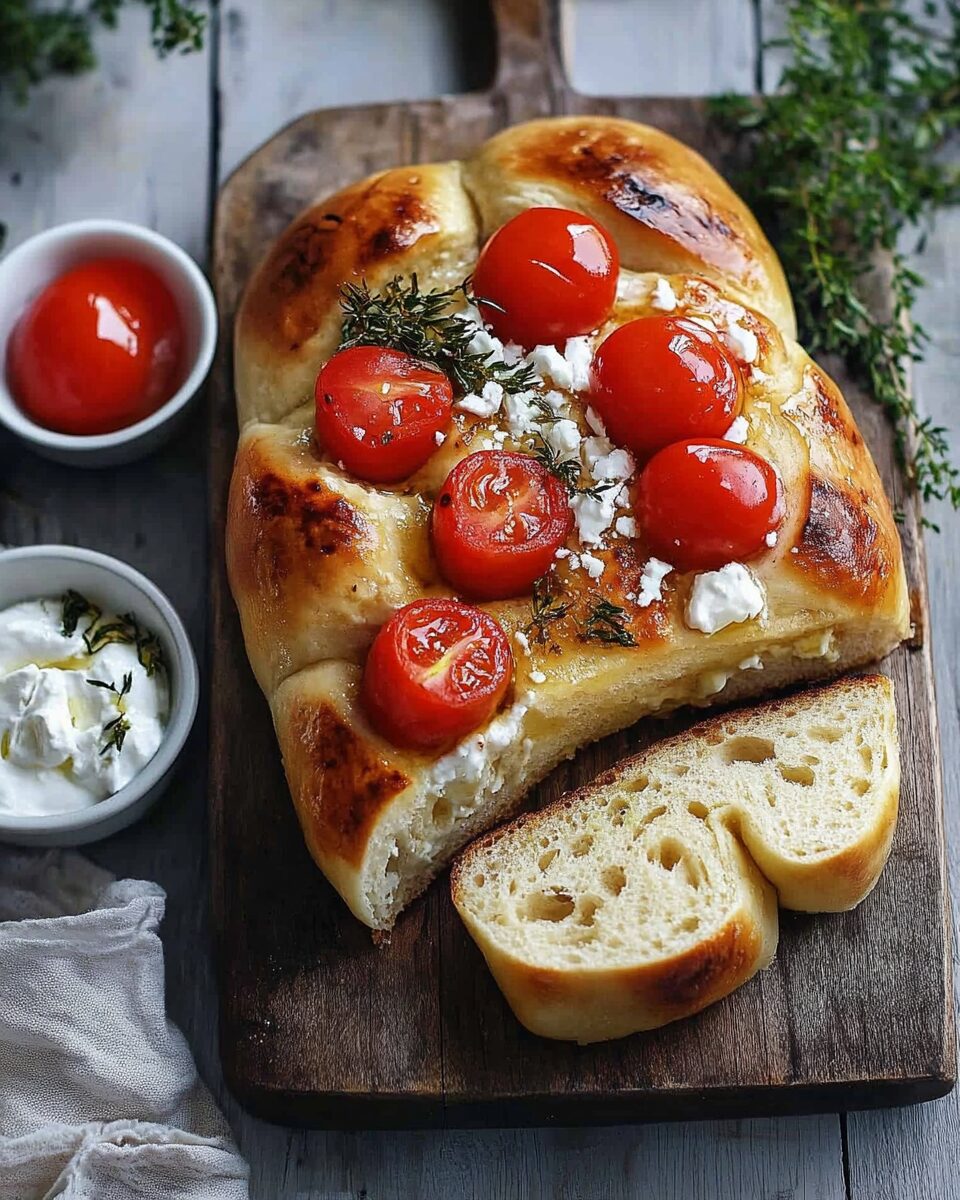Tsoureki is a stunning, golden-brown braided bread that embodies the essence of Greek Easter traditions. Infused with mahlep and orange zest, this soft and slightly sweet bread is beautifully fragrant and incredibly delicious. The fluffy interior contrasts perfectly with its glossy crust, creating an irresistible combination that makes it the centerpiece of any festive gathering. Not only is Tsoureki a staple during Easter celebrations, but it’s also an incredibly versatile treat. Enjoy it fresh with a spread of butter, dunked into coffee, or even repurposed into indulgent French toast. Its rich texture and delicate sweetness make it the ultimate holiday bread that brings families together, whether for a special brunch or a nostalgic taste of Greek heritage.
Full Recipe:
Ingredients:
-
Starter:
- 1/2 cup (60g) all-purpose flour
- 1/2 cup (113g) water
- 1/4 teaspoon instant yeast
-
Dough:
- 1/4 cup (57g) unsalted butter, melted
- 3 1/2 cups (420g) all-purpose flour
- 1/3 cup (67g) granulated sugar
- 2 tablespoons dry milk powder
- 1 1/2 teaspoons salt
- 1/2 teaspoon mahlep (or 1/2 teaspoon almond extract)
- 1 tablespoon orange zest
- 2 large eggs
- 2 teaspoons instant yeast
- 3/4 cup (170g) water
-
Topping:
- 1 large egg (for egg wash)
- 1/4 cup honey + 1 tablespoon water (optional for glaze)
- 3 to 5 hard-boiled eggs (optional for decoration)
Directions:
- Prepare the starter: Mix the starter ingredients in a bowl, cover, and let sit for 1 hour until bubbly and airy.
- Prepare the dough: Melt butter and set aside to cool. In a separate bowl, mix 1 cup flour with sugar, dry milk, salt, and mahlep.
- Stir eggs into the risen starter, then mix in cooled melted butter and orange zest.
- Gradually add the flour mixture and remaining flour until a soft dough forms. Knead until smooth and elastic.
- Cover the dough and refrigerate overnight (8–12 hours).
- The next day, remove the dough and knead gently to deflate.
- Divide into three pieces, roll into 16-inch strands, and braid. If using eggs, tuck them into the braid at intervals.
- Place the braid on a parchment-lined baking sheet, cover, and let rise for 2–2.5 hours.
- Preheat oven to 350°F (175°C). Brush with beaten egg wash.
- Bake for 20 minutes, then gently press the eggs further into the braid. Continue baking for 40–50 minutes until golden brown (internal temp: 190°F).
- If desired, brush with warm honey glaze. Cool completely before serving.
Prep Time: 15 minutes | Cooking Time: 1 hour | Total Time: 9+ hours (including resting)
Kcal: 250 kcal per slice | Servings: 12 slices
The Origins and Cultural Significance of Tsoureki
Tsoureki has been a part of Greek Easter traditions for centuries. Like many other cultures around the world, Greeks celebrate Easter with food that carries symbolic meaning. Tsoureki, with its three-strand braid, is said to represent the Holy Trinity in Christianity Father, Son, and Holy Spirit. The bread is often adorned with red-dyed eggs, which symbolize the blood of Christ and his resurrection.
The tradition of sweet Easter bread is not unique to Greece. Many cultures have their own versions of festive bread, such as Panettone in Italy, Challah in Jewish traditions, and Babka in Eastern Europe. However, Tsoureki stands out due to its distinctive flavor profile, which is attributed to two unique spices: Mahlep (or Mahlab) and Mastiha (or Mastic gum).
What Makes Tsoureki Unique?
The distinguishing factor of Tsoureki lies in its aroma and texture. Unlike plain sweet breads, Tsoureki is enriched with flavors that make it unmistakably Greek. Here are the characteristics that make it special:
- Mahlep: A spice made from the seeds of St. Lucie cherries, Mahlep has a sweet, nutty, and slightly floral taste. It gives Tsoureki a subtle almond and cherry-like aroma that sets it apart from other breads.
- Mastiha (Mastic gum): This resin, derived from the mastic tree native to the Greek island of Chios, has a unique, slightly piney, and aromatic quality. It enhances the depth of flavor in Tsoureki.
- Soft and Chewy Texture: The use of butter, eggs, and sugar in the dough creates a rich and tender crumb, while the long kneading process and slow fermentation result in an elastic and slightly stringy texture. This makes each bite of Tsoureki satisfyingly soft yet structured.
- Golden Brown, Glossy Crust: Brushed with an egg wash before baking, Tsoureki develops a shiny and golden-brown exterior, making it visually appealing and perfect for festive tables.
Variations of Tsoureki
Although Tsoureki is most commonly associated with Easter, there are several variations enjoyed throughout the year. Some of these include:
- Christmas Tsoureki: Sometimes made with additional spices like cinnamon and nutmeg or decorated with almonds and pearl sugar for a festive twist.
- Chocolate-Filled Tsoureki: A modern take on the classic recipe, this version includes swirls of chocolate or Nutella in the dough.
- Savory Tsoureki: While less common, some versions are made with cheese or herbs for a more bread-like, non-sweet variation.
- Stuffed Tsoureki: Filled with ingredients such as chestnut cream, dried fruit, or nuts, making it an indulgent treat for any occasion.
Best Ways to Enjoy Tsoureki
One of the best things about Tsoureki is its versatility. While it is delicious fresh out of the oven, it can be enjoyed in many different ways:
- Plain with Butter or Jam: A simple yet satisfying way to enjoy Tsoureki is by spreading butter or fruit jam on a warm slice.
- Paired with Greek Coffee: Tsoureki’s sweetness pairs beautifully with a strong cup of Greek coffee or espresso.
- Turned into French Toast: Leftover Tsoureki makes an incredible French toast, as its rich and slightly chewy texture soaks up egg custard beautifully.
- Used in Bread Pudding: If the bread becomes slightly stale, repurpose it into a decadent bread pudding with cinnamon, vanilla, and custard.
- With Nutella or Honey: A drizzle of honey or a spread of Nutella takes this bread to a whole new level of indulgence.
Why Tsoureki Remains a Beloved Tradition
In Greek culture, Tsoureki is more than just a recipe it is a symbol of togetherness, tradition, and celebration. Families gather around the kitchen to knead and braid the dough, passing down the technique from generation to generation. The slow fermentation process, the distinct aromas of mahlep and mastiha filling the house, and the joy of sharing the finished loaf with loved ones create a sense of nostalgia and warmth.
Moreover, the act of gifting Tsoureki is common during Easter. Many Greeks prepare multiple loaves to share with family, friends, and neighbors, reinforcing the spirit of generosity and hospitality that is central to Greek culture.
Conclusion:
Tsoureki is much more than just a sweet bread it is a rich cultural tradition, a symbol of faith, and a delightful treat that has stood the test of time. Its unique flavors, soft and chewy texture, and versatility make it an essential part of Greek Easter celebrations and beyond.
Whether you are baking Tsoureki for the first time or have been enjoying it for years, this bread brings a taste of Greek heritage to your table. Its aroma, texture, and cultural significance make it a must-try for anyone who appreciates traditional baked goods with deep-rooted history.
If you haven’t tried making Tsoureki yet, consider adding it to your baking repertoire you’ll not only enjoy a delicious loaf but also experience a cherished Greek tradition that continues to bring families and friends together.

